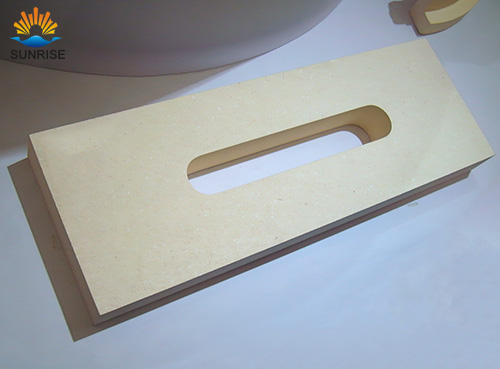The Drying Process of Corundum Brick
Date:2016-06-12 19:28 From:Zhengzhou Sunrise Refractory Author:admin
The drying system is the total drying conditions of corundum brick. It includes drying time, staring temperature and humidity, the final temperature and humidity, the initial moisture and residual moisture.

Currently, in medium and large refractory palnts, corundum bricks are dried in tunnel dryers. The drying time is expressed with the cart time internal. The cart time internal is related to the properties and structure of raw materials, the shape and size of bricks, the initial moisture and the residual moisture, the temperature of the drying media, the humidity and flow rate and the structure of dryers.
Generally, the cart time internal is 15-45min. large and seprical products should be dryied naturally for 24-48h and then dried in dryers to avoid cracks caused by too fast drying.
The pressure in the dryer is positive to prevent the inhalation of cold air. If the drying medium is waste gases, the pressure should be slightly positive or slightly negative to prevent the overflow of gases and unhealthy effect on workers.
The residual moistrue of the corundum brick can be determined by the following factors:
(1) Its mechanical strength should meet the requirements of transporting and loading.
(2) It should meet the requirements of fast rising of temperature in the initial period to prevent the cracks caused by the superheated vapor.
(3) The size and thickness of corundum brick. Generally, large and special products with complex shapes have a low residual moisture.
(4) Different types of firing kilns have different requirements.
Too low residual moisture is not essential, because to dicharge the final part of water is not economic and too dry corundum brick is brittle and difficult to be transported and installed.
The drying devices include tunnel dryer, chamber dryer and other types of dryers. The drying methods can be divided into natural drying, gaseous medium forced convection drying, microwave drying and electric drying.
The drying process can be divided into 3 steps:
(1) The first stage is the most important phase of the drying process. A large amount of water is discharged at this stage. During the process, the drainage speed is constant, so it is called the constant drying stage. In this stage, the evaporation of water only occurs on the surface. The drying speed is equal to the evaporation rate of the free water on the surface. Therefore, the the factors that affect the evaporation rate can also affect the drying rate. Therefore, in the constant drying stage, the drying speed have nothing to do with the thickness and initial moisture of corundum brick.
(2) The second process is the falling rate drying process. With the increase of the drying time or the decrease of moisture, the effective evaporation area and the drying rate graduallydecrease. The evaporation rate is faster than the diffusion speed from the interior to the surface. So the drying rate is less affected by the air temperature, humidity and velocity. The diffusion speed depends on the water content, the internal structure, water viscosity and material properties. Typically the diffusion of water in non-plastic and weak plastic materials is strong. The bigger the particle size and the higher the temperature, the bigger the diffusion speed.
(3) In the third stage, the drying rate gradually approaches zero. Finally, the moisture of the bricks is constant. When the dry bulb temperature of the air is less than 100℃, the moisture in the brick is called the equilibrium moisture content, which is adhered to the solid particles. The equilibrium moisture content is up to the properties of raw materials, particle size and the temperature and humidity of the drying media.
